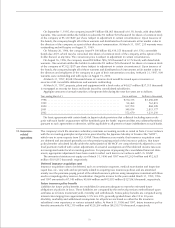Sony 1997 Annual Report Download - page 61
Download and view the complete annual report
Please find page 61 of the 1997 Sony annual report below. You can navigate through the pages in the report by either clicking on the pages listed below, or by using the keyword search tool below to find specific information within the annual report.
59
18. Commitments
and contingent
liabilities
Commitments outstanding at March 31, 1997 for the purchase of property, plant and equipment and other
assets approximated ¥49,562 million ($399,694 thousand).
Contingent liabilities for notes discounted and guarantees given in the ordinary course of business and for
employee loans amounted to ¥98,377 million ($793,363 thousand) at March 31, 1997.
The company has entered into agreements with financial institutions whereby the company can sell up to
¥62,000 million ($500,000 thousand) of specifically identified accounts receivable and future receivables
with limited recourse. For the years ended March 31, 1995, 1996 and 1997, the company did not sell any
specifically identified accounts receivable or future receivables. As of March 31, 1996 and 1997, the out-
standing balance of all receivables sold with limited recourse amounted to ¥6,678 million and ¥868 million
($7,000 thousand), respectively.
The company has also entered into agreements with financial institutions whereby the company can sell up
to ¥117,800 million ($950,000 thousand) of undivided interests in a pool of eligible receivables with limited
recourse. The maximum pool of eligible receivables sold outstanding at any one time during the years ended
March 31, 1995, 1996 and 1997 amounted to ¥72,535 million, ¥71,868 million and ¥0 million ($0 thousand),
respectively. As of March 31, 1996 and 1997, there were no outstanding balances of receivables sold.
Under the terms of each of the receivable sale agreements, the company has retained substantially the
same risk of credit loss as if the receivables had not been sold. The company has fully reserved for these
potential credit losses. The company pays fees which approximate the purchasers’ costs of issuing commer-
cial paper and are included in other expense.
Certain subsidiaries in the music entertainment industry entered into long-term contracts with recording
artists and companies for the production and/or distribution of prerecorded music and videos. These contracts
cover various periods mainly through March 31, 2000. As of March 31, 1997, these subsidiaries were
committed to make payments under such long-term contracts of ¥21,545 million ($173,750 thousand).
The company and certain of its subsidiaries are defendants in several pending lawsuits. However, based
upon the information currently available to both the company and its legal counsel, management of the
company believes that damages from such lawsuits, if any, would not have a material effect on the company’s
consolidated financial statements.
19. Business
segment
information
The company operates on a worldwide basis principally within three industry segments: 1) Electronics,
2) Entertainment and 3) Insurance and financing. The Electronics segment designs, develops, manufactures
and distributes video equipment, audio equipment, televisions and other products. The Entertainment seg-
ment manufactures, markets and distributes music and pictures entertainment products. The Insurance and
financing segment represents insurance business, primarily individual life insurance business in the Japanese
market, and other financing business, which consists of customer financing and leasing business also in the
Japanese market.


















